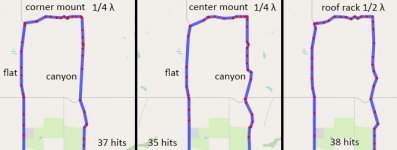OK, so the 1/4 wave ground plane vs 1/2 wave NGP vs 5/8 wave GP discussion is very well documented and diagrammed online. In short, the 1/4 wave has a rounded pattern that sends more signal vertically, whereas the 1/2 and 5/8 wave have flatter, further reaching horizontal lobes. So the 1/2 wave is better for flat landscapes because you can get more distance per watt, but if you are in hilly terrain, a 1/4 wave could be an advantage to get over the landscape.
After my 1/2 wave was ripped off my truck, before buying a new one I put my old 1/4 wave mag mount back on and for interest ran some tests. I have a route I go where there are low “canyon” type areas that transmitting out of is usually more difficult. I found the 1/4 wave was in fact almost twice as good at getting out of the canyon as the much taller 1/2 wave, so much better that I was quite surprised.
So a 1/4 wave doesn’t have as far a range per watt on a flat landscape – but with a maximum range of 160 kms due to the curvature of the earth, can’t this just be overcome with power? If you had enough power, wouldn’t the 1/4 wave be the best solution by far, as the vertical component would handle the hills better, and the ~20% loss in horizontal range (compared to a 1/2 or 5/8 wave) easily overcome with a few more watts?
So to the question finally – how much power do you need to push a 1/4 wave antenna out to 160 kms on VHF, if mounted on the roof of a truck? I have 80 watts in my mobile and although I didn’t have much time to test, I made it easily to 130 km repeaters on the flats.
Btw this all part of trying to decide if I should stick with my roof rack mounted 1/2 wave (because of the not so great GP of a roof rack mount) or to mount a 1/4 wave directly to the roof (which has problems too because I can’t put it in the center). Or put the 1/4 wave on the roof rack without such a good GP…so many combinations.
Thanks
After my 1/2 wave was ripped off my truck, before buying a new one I put my old 1/4 wave mag mount back on and for interest ran some tests. I have a route I go where there are low “canyon” type areas that transmitting out of is usually more difficult. I found the 1/4 wave was in fact almost twice as good at getting out of the canyon as the much taller 1/2 wave, so much better that I was quite surprised.
So a 1/4 wave doesn’t have as far a range per watt on a flat landscape – but with a maximum range of 160 kms due to the curvature of the earth, can’t this just be overcome with power? If you had enough power, wouldn’t the 1/4 wave be the best solution by far, as the vertical component would handle the hills better, and the ~20% loss in horizontal range (compared to a 1/2 or 5/8 wave) easily overcome with a few more watts?
So to the question finally – how much power do you need to push a 1/4 wave antenna out to 160 kms on VHF, if mounted on the roof of a truck? I have 80 watts in my mobile and although I didn’t have much time to test, I made it easily to 130 km repeaters on the flats.
Btw this all part of trying to decide if I should stick with my roof rack mounted 1/2 wave (because of the not so great GP of a roof rack mount) or to mount a 1/4 wave directly to the roof (which has problems too because I can’t put it in the center). Or put the 1/4 wave on the roof rack without such a good GP…so many combinations.
Thanks



